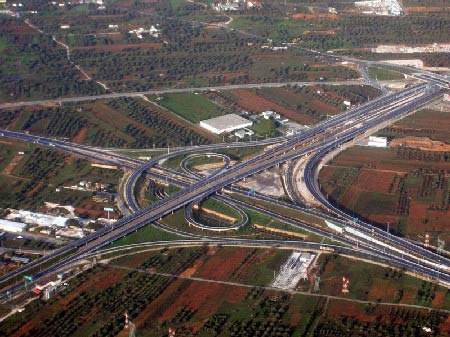Athens International Airport, which is situated about 20km east of Athens (the journey by road is 30km due to roads winding around hills), was officially opened in March 2001, after five years of construction at a total cost of around €2.1bn.
The owner of the airport is Athens International Airport SA, with 55% of shares held by the Greek state, and the rest owned by a private consortium. The airport is located between the towns of Markopoulo, Koropi, Spata and Loutsa and is named after Elefthérios Venizélos, a well known Cretan politician and prime minister of Greece of the 19th century.
The new airport was completed on time and within budget and was assigned a nominal capacity of around 16 million passengers a year and 220,000t a year of cargo.
AIR TRAFFIC VOLUMES
The new airport, called Elefterios Venizelos Airport, was necessary to replace the existing, 11-million-passengers-a-year facility at Hellenikon to the south of Athens, which was no longer capable of coping with increasing air traffic.
The airport is capable of handling 65 take-offs and landings an hour, or 600 a day. Capacity will eventually be expanded by phase six to accommodate 50 million passengers a year.
Phase one of the airport can accommodate 16 million passengers a year. In 2006 the airport hosted 15,079,000 passengers (5.6% increase over 2005) and over 190,000 aircraft movements.
EXPENSIVE BUT HIGHLY REGARDED
Elefterios Venizelos airport is regarded as one of Europe’s most expensive airports, with restaurants and cafes paying very high rents, and airline companies accommodating extremely high landing fees.
The airport was awarded the title of ‘European Airport of the Year 2004’ at the 2004 Institute of Transport Management (ITM) Awards, for its innovation, operation and achievements. In 2005 and 2006, the airport was also awarded the Skytrax award for best airport in Southern Europe.
RUNWAYS AND TAXIWAYS
The airport was designed with two parallel runways enabling simultaneous take-offs and landings. The two asphalt paved runways are 4,000m and 3,800m long respectively and are connected to a double taxiway system. Passenger aircraft park at 73 aircraft stands and 24 apron drive passenger boarding bridges service the terminal and satellite building.
Halcrow were awarded the contract to design and supervise the construction of aprons and taxiways including a drainage solution, ground lighting and signage for a total contract value of £10m.
TERMINAL AND SATELLITE BUILDINGS
The new main terminal at Athens International Airport has a total floor surface of 150,000m² on four levels with 14 passenger boarding bridges and features. It can service around ten million passengers a year. The satellite building hosts ten passenger boarding bridges and can accommodate another six million passengers a year.
An underground walkway links the terminal and satellite buildings and a railway station is situated immediately adjacent to the airport terminal, which is accessible by a convenient elevated walkway.
The rail link was completed in time for the 2004 Olympics and is served by line 3 of the Athens Metro and by the Proastiakos suburban train service.
The airport is also fully accessible from the nearby Attiki Odos highway with new link roads now fully open.
AIR TRAFFIC MANAGEMENT
Thales ATM supplied, installed and tested air navigation systems for a total contract value of around €84m. Approved by the Greek Civil Aviation Authority, the system performs all air traffic control and backbone communications.
The system includes ASDE radar (Airfield Surface Detection Equipment), an A-SMGCS (Advanced Surface Movement Guidance and Control System) as well as a complete tower system and control centre. In the event of low visibility, Athens International Airport relies on specialised systems for ‘blind landing’ (ILS CAT II).
FUEL DISTRIBUTION
Olympic Fuel Company SA (OFC), a joint venture led by Olympic Airways, obtained a fuel concession for Athens Airport. The installations to date include six positions capable of unloading from more than 100 over-the-road trucks a day, four 6,000m³ above-ground storage tanks with a total capacity of 6.3 million gallons and a foam and water storage and distribution system.
Furthermore, installations comprised a hydrant pumping, filtration and distribution system capable of supplying 2,500m³ of fuel an hour (11,000gpm) through about 14.5km of underground pipes. Security and loss from spillage is prevented by an electronic leak detection system.
BAGGAGE HANDLING SYSTEM
ABB Airport Systems won the baggage-handling equipment contract jointly with Mannesmann Dematic. This involved the supply and installation of 144 check-in counters, 16 racetracks and two tilt tray sorters as well as around 3,000m of belt conveyors.
Glidepath supplied 11 pallet loop carousels as well as draft curtains for conveyor throughways. Baggage flows were simulated on AutoMod™ simulation software prior to system start-up.
CAR PARKING
Construction of Athens International Airport further included a parking facility with capacity for around 4,700 vehicles, located in front of the terminal building and across the six-lane Attiki Odos highway that constitutes the Athens ring road.
Variable message signs provide continuous information about parking space availability and users can pay fees at automated machines as well as at manned, 24-hour cashier booths.
CCTV SYSTEMS
Plettac Electronics undertook design, planning and installation of the Closed-Circuit Television (CCTV) Cameras systems at the airport. Cameras are installed throughout the public and non-public areas, in air traffic control and baggage handling zones.
The CCTV security system comprises 145 fixed-head colour cameras, 79 SpeedVisionDomes and 36 PTZ cameras. A smaller CCTV system is used by traffic control staff to guide aircraft on the ground by monitoring movements with 17 FAC 830 PTZ cameras.
The baggage-handling system is monitored by 124 fixed-head colour cameras, which use an LE90 transmission system, a VAZ 300 video matrix, recorders and a printing facility.
ROBOTIC SECURITY SYSTEMS
The airport is equipped with two specialised robotic systems (the robots are named Hercules and Ulysses), which are capable of handling suspect devices and bags. The equipment was designed to protect lives as well as the airport itself, by safely identifying and removing explosive devices.
The Hercules robot was donated by the Stavros Niarchos Foundation..The system is capable of the safe collection and transportation of explosives for disposal. It is equipped with a spherical-shaped tank (reinforced to a very high specification) with a diameter of 120cm, and two robotic folding arms.
Ulysses is a robotic system worth €94,000, which was donated by Soukos Robots ABEE. This system was constructed to serve as a back-up auxiliary system to the Hercules robot, allowing entrance in problematic cramped access areas such as toilets, coaches or aircraft. The robot is light and highly efficient and is equipped with a shock-absorbing system allowing it to undertake movements on rough surfaces.
OTHER DEVELOPMENTS
The airport construction also involved numerous sub-projects, including a new fire brigade building, a new hotel, power facilities, Olympia Airline’s catering unit and numerous commercial units. Milgo Solutions designed, delivered and commissioned high-speed fibre-optic cabling to carry data such as radar, weather and support systems information.
AIRPORT OWNERSHIP AND OPERATION
Athens International Airport SA a partnership of the Hellenic Republic (55%) and a private consortium (45%) will operate the Eleftherios Venizelos Airport for a period of 30 years starting in 2001.
The BOOT (Build-Own-Operate-Transfer) contract was awarded to the private consortium, led by German construction company Hochtief. The partners are Hochtief AirPort GmbH (36.125%), ABB Calor Emag Schaltanlagen AG (5%), H.Krantz-TKT GmBH (3.75%) and Flughafen Athen-Spata Projektgesellschaft mBH (0.125%). Private Greek contractors undertook around 70% of the construction work.
FUNDING
The construction of Athens International Airport was financed by a European Investment Bank (EIB) loan of €997m (45% of total funds), €312m (14%) of commercial bank loans (a consortium lead by Vereinsbank), €250m (11%) of European Union grants, €150m (7%) of grants from the Greek State, €134m (6%) of shareholder loans as well as a range of smaller amounts from other sources.













